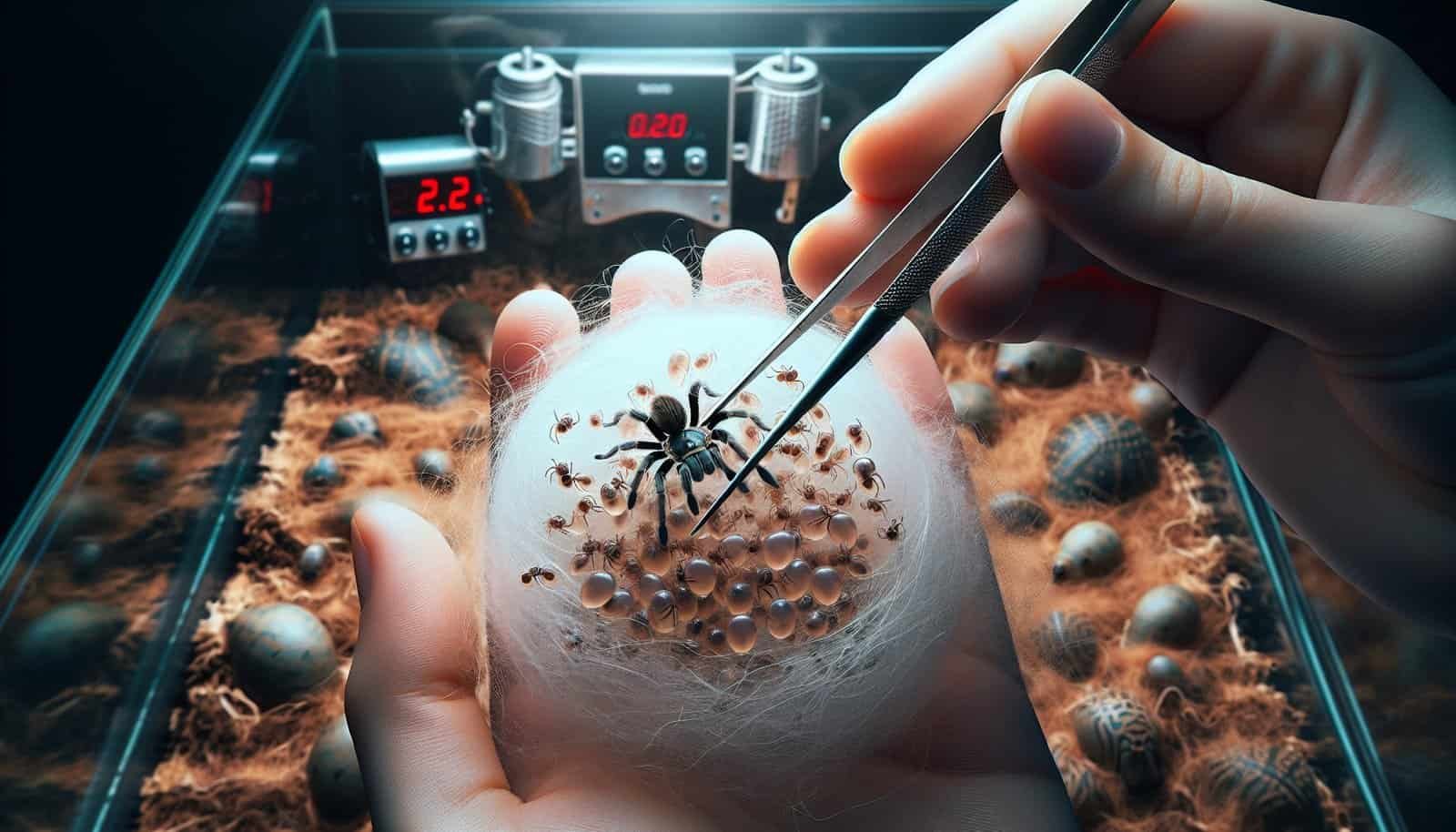Congratulations, you’re about to embark on an exciting journey! The anticipation of seeing tarantula eggs hatch is undeniably thrilling, but tending to these delicate orbs during incubation is crucial for a successful outcome. So, how exactly do you care for tarantula eggs during this vital stage? From maintaining optimum temperature and humidity levels to ensuring a peaceful environment, we’ll guide you through the necessary steps to support the development of these fascinating creatures. Let’s dive in and discover how you can become the best caretaker for your tarantula eggs during incubation!
Tarantula Eggs
Tarantulas, as fascinating arachnids, have a unique reproductive process. The female tarantula lays eggs in a protective sac, which she then incubates until they hatch into adorable spiderlings. If you find yourself fortunate enough to be caring for tarantula eggs, it is essential to provide them with the optimal conditions for healthy development. In this article, we will guide you through the journey of tarantula egg care, from setting up the incubator to post-hatching care and bonding with the mother. So, let’s get started!
Tarantula Reproduction
Before we delve into the nitty-gritty of tarantula egg care, let’s take a moment to understand tarantula reproduction. In the wild, the male tarantula must woo the female through an elaborate courtship dance to mate successfully. Once mated, the female will produce an egg sac, carefully protecting it until maturity. The egg sac serves as a warm and secure environment for the eggs to develop, safeguarding them from potential harm.

Tarantula Egg Development
Tarantula eggs undergo a fascinating development process within the egg sac. From the moment they are laid, these tiny future spiders start their journey to life. The eggs will go through several stages of development, each vital for the spiderlings’ growth. Throughout this process, it is crucial to provide the eggs with the right conditions to ensure their survival and successful hatching. Now, let’s move on to setting up the incubator.
Setting Up the Incubator
Choosing an appropriate incubator is the first step in creating an optimal environment for tarantula eggs. It’s important to select one that provides stable temperature and humidity control. Several options are available, including commercial tarantula egg incubators or DIY setups. Whichever option you choose, make sure it suits your specific needs and budget.
Temperature and Humidity Control play a central role in tarantula egg incubation. Maintaining a stable temperature range is crucial, as fluctuations can disrupt the development process. The ideal temperature range for tarantula eggs is typically around 80 to 85 degrees Fahrenheit (27 to 29 degrees Celsius). Investing in a reliable thermometer and heating source will help you monitor and maintain the temperature accurately.
Equally important is ensuring the incubator maintains the appropriate humidity levels. Tarantula eggs require a humid environment, mimicking the conditions within the female’s natural egg sac. Aim for a humidity level of around 75 to 80%. This can be achieved by misting the incubator regularly or using a moisture substrate.
Incubator Substrate is another critical factor to consider. The substrate should provide moisture and stability for the eggs. Using a combination of vermiculite and water or even coco fiber can help create a suitable substrate. Avoid excessively wet or dry substrates as they can harm the delicate eggs.
Strategic Incubator Placement is necessary for the well-being of the eggs. It’s advisable to keep the incubator away from direct sunlight and drafts that can impact temperature and humidity stability. Choose a quiet and undisturbed area to minimize external disturbances that could stress the developing spiderlings.

Preparing the Eggs
Before you place the eggs in the incubator, it’s crucial to remove them from the egg sac. Gently separate the eggs from the sac, taking care not to damage them. You may find it helpful to use a pair of clean, sterilized tweezers or a soft paintbrush for this delicate process. Ensure that your hands are clean and free from any substances that could harm the eggs.
Inspecting the eggs is an essential step to identify any potential issues early on. Look for any discoloration, abnormalities, or signs of damage. Remove any eggs that appear unhealthy, as they may not be viable and could potentially harm the others.
Temperature and Humidity Control
As mentioned earlier, maintaining an optimal temperature range is vital for the well-being of tarantula eggs. Slight deviations from the recommended temperature can significantly impact the development process. Invest in a reliable temperature control system to ensure the eggs receive the consistent warmth they need.
Alongside temperature control, stable humidity is equally crucial. Fluctuations in humidity levels can lead to dehydration or excessive moisture, both of which can be detrimental to egg development. Consistently monitor and adjust humidity levels within the incubator by misting or using a hygrometer.

Handling the Eggs
When caring for tarantula eggs, it is essential to avoid direct contact with them. While they may seem sturdy, the eggs are incredibly delicate and sensitive to external pressure. Touching them with bare hands or any foreign objects can potentially harm or damage the eggs. Always use sterilized tools when necessary, ensuring their cleanliness to prevent any contamination.
Another vital aspect of handling tarantula eggs is maintaining cleanliness. Tarantulas are susceptible to bacterial and fungal infections, which can be harmful to the eggs. Regularly clean and sanitize the incubator to eliminate any potential pathogens. This includes changing the substrate if necessary and keeping the incubator environment as clean as possible.
Monitoring Development
As the tarantula eggs progress through their various growth stages, it’s important to monitor their development closely. Understanding the embryo growth stages can help you assess their health and viability. Keep an eye out for any signs of abnormal growth, discoloration, or lack of progress. Regular observation will allow you to take necessary actions promptly.
Checking for viability is crucial during the incubation period. Viable eggs will show signs of growth and development, with identifiable spiderlings forming within. Non-viable eggs may appear shriveled, discolored, or lack any signs of life. It’s recommended to remove non-viable eggs to prevent any potential issues from arising.

Protecting the Eggs
During the incubation period, it’s essential to protect the tarantula eggs from potential predators and microbial infections. Setting up predator prevention measures is crucial to ensure the safety of the developing spiderlings. Keep the incubator in a secure place, away from other animals or pests that may pose a threat.
Microbial infections can also be a significant concern during egg incubation. To prevent such infections, maintain a clean and sanitary incubator environment. Regularly inspect for any signs of mold or mildew growth and promptly remove any contaminated substrate. Sterilize tools and equipment used for handling the eggs to prevent introducing harmful microbes.
Preparing for Hatching
As the incubation period nears its end, it’s important to make the necessary preparations for hatching. The egg sac webbing plays a vital role in the hatching process. It provides a safe location for the spiderlings to emerge and ensures their ability to disperse effectively. Ensure that the webbing is intact and undisturbed, providing a suitable environment for hatching.
The duration of the incubation period varies among tarantulas, with some species taking weeks and others months. Research the specific species you are caring for to determine the approximate duration of incubation. Patience is key during this period, as premature interference can disrupt the natural hatching process.
Hatchling Enclosure should be ready by the time the spiderlings emerge from their eggs. Provide a secure and suitable habitat for the newborns to ensure their survival. Small, well-ventilated containers with appropriate substrate and hiding places are essential in welcoming the emerging tarantulas.

Hatchling Care
Once the spiderlings have hatched, their care requirements evolve. Providing hiding places is crucial to help them feel secure and reduce stress. Miniature shelters such as tiny hollowed logs or artificial plants create a sense of security for the hatchlings.
Feeding the hatchlings is another important aspect of their care. Small prey items like fruit flies, small crickets, or pinhead crickets should be offered as their primary food source. Take care not to overwhelm the hatchlings with prey that is too large, as it may pose a choking or injury risk.
Bonding with Mother
After the hatching process, you may be wondering about the mother tarantula’s role in caring for her young. In most cases, it is best not to reintroduce the spiderlings to the mother. Tarantulas are generally solitary creatures, and the presence of the spiderlings may cause stress or aggression. Instead, continue providing optimal care for the spiderlings within their separate enclosures.
Post-Hatching Care involves maintaining the hatchlings’ habitat and ensuring their continued growth and development. Monitor their progress closely, offering appropriate food and a suitable environment. As they grow, periodically adjust their enclosure to accommodate their increasing size.
Caring for tarantula eggs during incubation is a rewarding journey, allowing you to witness the incredible transformation from eggs to spiderlings. By providing the optimal conditions, you are nurturing the future generation of these fascinating creatures. Remember to always prioritize their well-being and consult with experts or reputable sources for any specific information regarding the species you are caring for. So sit back, relax, and enjoy the journey of tarantula egg incubation!
